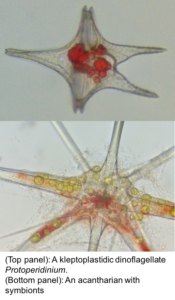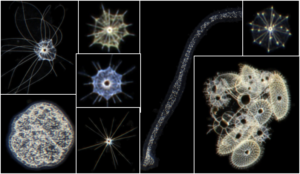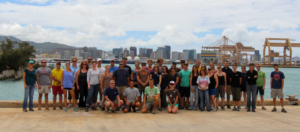 Photosynthetic protists (aka microalgae), together with cyanobacteria, form the base of the food web in oceanic ecosystems. Heterotrophic protists (aka protozoa) are major consumers of that biomass. As such, they occupy the next few trophic steps of pelagic food webs, and fundamentally affect the pathways of carbon flow and energy utilization. Tremendous effort has been spent on understanding primary productivity, but less is known about consumer-side processes, and the diversity and life histories of the species that contribute to those processes. An added complication is that many protists are not purely photosynthetic (plant-like) or heterotrophic (animal-like), but exhibit ‘mixed’ nutrition (see ‘Comparative Functional Analyses of Mixotrophy among Microbial Eukaryotes’ in Completed Research section). Mixotrophic protists, species that combine significant aspects of both photosynthetic and heterotrophic nutrition, constitute a wide array of taxa and abilities ranging from phagotrophic phytoflagellates (algae that are capable of ingesting and digesting various prokaryote and eukaryotic prey), to kleptoplastidic ciliates and dinoflagellates (which retain functional chloroplasts of algae that they eat), to numerous heterotrophic protists that live symbiotically with photosynthetic protists (e.g. most of the larger Rhizaria). These species blur traditional trophic boundaries constructed by many oceanographers, complicating the inclusion of heterotrophic and mixotrophic protists and their activities into biogeochemical models.
Photosynthetic protists (aka microalgae), together with cyanobacteria, form the base of the food web in oceanic ecosystems. Heterotrophic protists (aka protozoa) are major consumers of that biomass. As such, they occupy the next few trophic steps of pelagic food webs, and fundamentally affect the pathways of carbon flow and energy utilization. Tremendous effort has been spent on understanding primary productivity, but less is known about consumer-side processes, and the diversity and life histories of the species that contribute to those processes. An added complication is that many protists are not purely photosynthetic (plant-like) or heterotrophic (animal-like), but exhibit ‘mixed’ nutrition (see ‘Comparative Functional Analyses of Mixotrophy among Microbial Eukaryotes’ in Completed Research section). Mixotrophic protists, species that combine significant aspects of both photosynthetic and heterotrophic nutrition, constitute a wide array of taxa and abilities ranging from phagotrophic phytoflagellates (algae that are capable of ingesting and digesting various prokaryote and eukaryotic prey), to kleptoplastidic ciliates and dinoflagellates (which retain functional chloroplasts of algae that they eat), to numerous heterotrophic protists that live symbiotically with photosynthetic protists (e.g. most of the larger Rhizaria). These species blur traditional trophic boundaries constructed by many oceanographers, complicating the inclusion of heterotrophic and mixotrophic protists and their activities into biogeochemical models.
 Our component of the SCOPE research project investigates protistan ecology at a study site north of the island of Oahu in the Hawaiian Islands (station ALOHA: A Long-term Oligotrophic Habitat Assessment). ALOHA is the site of a long-term time-series study (the Hawaii Ocean Time-Series (HOT), and there is a rich dataset and history of oceanographic and biogeochemical studies there. Our work involves several aspects of protistan biology:
Our component of the SCOPE research project investigates protistan ecology at a study site north of the island of Oahu in the Hawaiian Islands (station ALOHA: A Long-term Oligotrophic Habitat Assessment). ALOHA is the site of a long-term time-series study (the Hawaii Ocean Time-Series (HOT), and there is a rich dataset and history of oceanographic and biogeochemical studies there. Our work involves several aspects of protistan biology:
1. Characterization of protistan diversity using microscopy and gene-based surveys within the water column. The long-term goal of this work is to understand how microbial diversity translates to ecosystem function, and how function changes as community composition responds into environmental change. This work expands our coastal studies at the San Pedro Ocean Time-series), as well as some of our research on harmful algal blooms (see other Current Research projects).
 2. Studies to quantify phytoplankton growth and mortality (and various subcategories of the phytoplankton community: Prochlorococcus, Synechococcus, picoeukaryotic algae), as well as the fate of bacterial biomass. This work involves experimental incubations that provide information vital to understanding the flow of carbon and energy in the pelagic food web at ALOHA. One component of this work is the characterization of the contribution of mixotrophic algae (phototrophic algae that also consume prey) to the consumption of bacterial biomass at the study site.
2. Studies to quantify phytoplankton growth and mortality (and various subcategories of the phytoplankton community: Prochlorococcus, Synechococcus, picoeukaryotic algae), as well as the fate of bacterial biomass. This work involves experimental incubations that provide information vital to understanding the flow of carbon and energy in the pelagic food web at ALOHA. One component of this work is the characterization of the contribution of mixotrophic algae (phototrophic algae that also consume prey) to the consumption of bacterial biomass at the study site.
3. Establishment of laboratory cultures of ecologically-important photosynthetic and heterotrophic protists. A culture collection enables careful laboratory-based studies by SCOPE investigators and the larger research community of portistan species of significance at the study site, thus improving biogeochemical models of this oceanic community.
 4. Photographic documentation of delicate planktonic protists at station ALOHA using a new underwater plankton camera instrument. These images will provide some of the first quantitative information on these undersampled specimens, and help determine their contribution to sinking particles in the open ocean.
4. Photographic documentation of delicate planktonic protists at station ALOHA using a new underwater plankton camera instrument. These images will provide some of the first quantitative information on these undersampled specimens, and help determine their contribution to sinking particles in the open ocean.
5. Metatranscriptomic studies of microbial eukaryotes along a vertical profile at station ALOHA. Eukaryotic metatranscriptomes collectively assess all genes expressed by the eukaryotic community in a water sample. These approaches are becoming common as a means of assessing adaptations and responses of phytoplankton species to environmental change, but they are still rare for heterotrophic eukaryotes. Our goal in this work is to characterize gene expression of eukaryotes in the ‘twilight’ zone of the ocean (down to 1000 m), and compare the activities of these species to surface-dwelling populations. Another aspect of this work is to conduct ‘targeted’ transcriptomic studies of understudied microbial eukaryotes such as larger rhizaria and their symbiotic algae, with the goal of understanding how these symbioses are established and maintained.
For more information regarding the Simons Collaboration on Ocean Processes and Ecology (SCOPE) project, click HERE. For information regarding the Simons Foundation, click HERE. For more information on the Hawaii Ocean Time-Series (HOT), click HERE.
